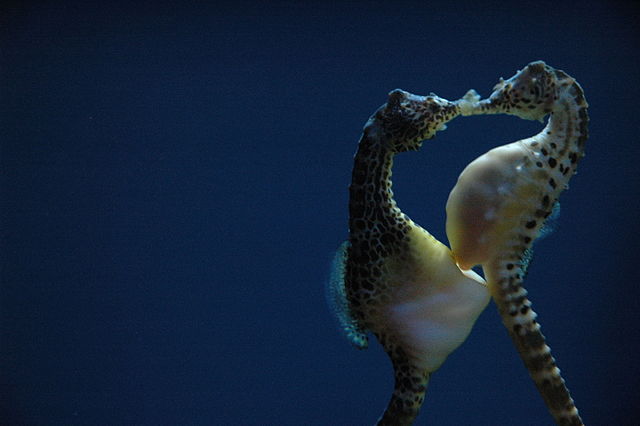During gestation, pot-bellied seahorse males provision the embryos
Seahorses are viviparous, and it is the males that are pregnant. In pot-bellied seahorse, Hippocampus abdominalis, males even provide the embryos with nutrients, Zoe Skalkos and colleagues discovered.
Some fish species are viviparous. In most cases, young fish are born from the mother, but in seahorses the father plays a unique role. He incubates the fertilized eggs in a fleshy, enclosed brood pouch until the offspring can live independently. In daddy’s pouch, the embryos are safe from small predators and pathogens. The pregnant father controls the water quality in the pouch; the highly vascularised pouch skin supplies oxygen and waste products are removed.
Males of pot-bellied or big-belly seahorse, Hippocampus abdominalis, that lives around Australia and New Zealand, also transport nutrients to their embryos, Zoe Skalkos and colleagues report.
Complex brood pouch
When seahorses mate, the female transfers her eggs into her partner’s brood pouch, which he has inflated by filling it with seawater. He fertilizes the eggs immediately and carries them until the young fish can be released. The developing embryos consume the large amount of high protein yolk that the eggs contain.
Pot-bellied seahorse is a large species, up to 35 centimeters long, and exhibits the most complex form of male pregnancy among seahorses. Young embryos are deeply embedded into the pouch’s lining tissue; some are completely covered. The embryos can survive on the amount of food that the yolk contains, according to experiments in which they developed outside a brood pouch. But young fish that are raised in this way exhibit stunted growth and suffer increased mortality. That is why the researchers wondered whether the pregnant father transports nutrients to his hundreds of young via the pouch wall.
Supplement
To find out, they compared the dry weight of newly fertilized eggs of pot-bellied seahorse with that of newborns, which are released after a gestation period of about 24 days. They also determined the fat content of eggs and newborns. From previous research, they knew that cell constituents that transport fats are produced in large quantities in the brood pouch of males during gestation. Fat is the primary source of energy for the embryos and they need a lot of it.
If the father would not supply nutrients to the embryos, the dry weight of newborn fish would be lower than that of newly fertilized eggs. That is because embryos consume the food supply that the mother provided; they gain weight, but part of the mass is lost by metabolism. The weight loss is estimated to be 30 to 40 percent.
However, as it turned out, newborns have the same dry weight as newly fertilized eggs. Also fat contents were similar. Most likely then, the father provides nutrition to his offspring, especially fats, to replace what is lost.
Pregnant in every sense
Pipefish are closely related to seahorses. Also in pipefish, fathers carry the embryos, although not all pipefish species possess a highly developed, enclosed brood pouch. In some pipefish species, as was known, pregnant males transport a small amount of nutrients to the embryos. Now, this also appears to happen in at least one seahorse species.
These fish dads are going through a pregnancy in every sense. However, compared to that of mammals, their pregnancy is not entirely complete, because the fish mothers still provide most nutrients to the embryos. But it certainly is extraordinary.
Willy van Strien
Photo: Pot-bellied seahorse mating. Elizabeth Haslam (Wikimedia Commons, Creative Commons CC BY 2.0)
Watch a video on courtship and birth in pot-bellied seahorse
Sources:
Skalkos, Z.M.G., J.U. Van Dyke & C.M. Whittington, 2020. Paternal nutrient provisioning during male pregnancy in the seahorse Hippocampus abdominalis. Journal of Comparative Physiology B 190: 547-556. Doi: 10.1007/s00360-020-01289-y
Whittington, C.M., O.W. Griffith, W. Qi, M.B. Thompson & A.B. Wilson, 2015. Seahorse brood pouch transcriptome reveals common genes associated with vertebrate pregnancy. Molecular Biology and Evolution 32: 3114-3131. Doi: 10.1093/molbev/msv177
